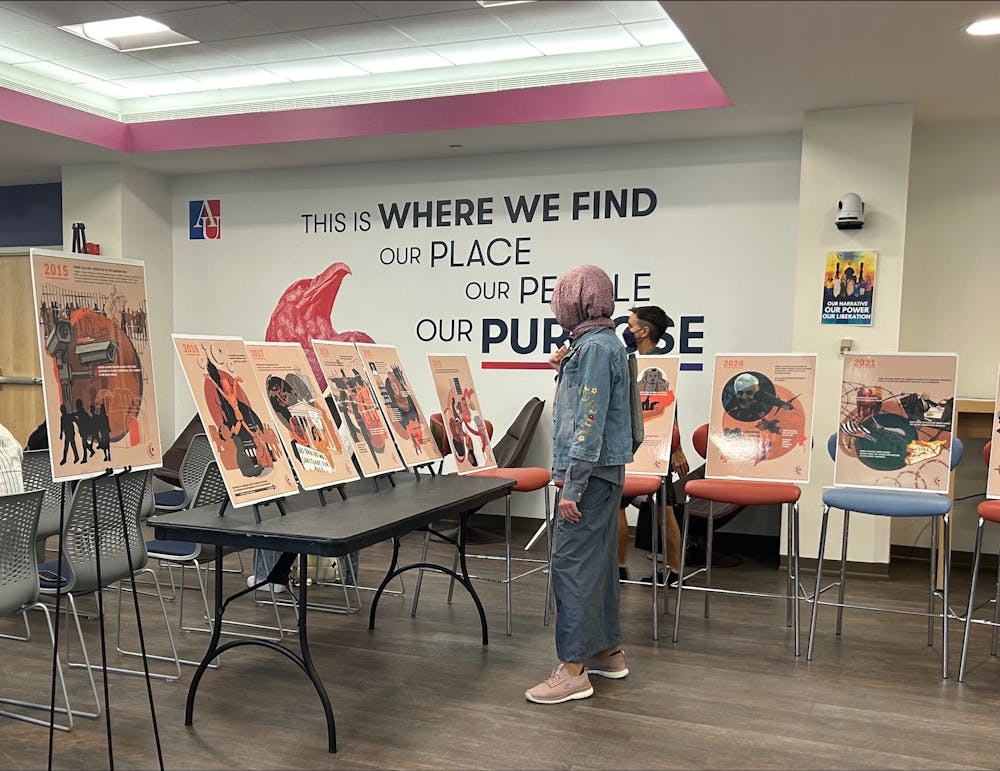The Department of Critical Race, Gender & Culture Studies, along with the AU Muslim Students Association welcomed three guest speakers to American University on Oct. 4 to address how Islamophobic narratives have developed over time.
The speakers — comedian Bryant “Preacher” Moss, writer Maha Hilal and journalist Assia Boundaoui — shared their experiences as Muslim Americans and spoke to institutionalized Islamophobia they have witnessed increasing in the U.S.
Hilal said the accompanying art exhibit showcased in Mary Graydon Center during the event was meant to represent the Muslim American perspective both pre-and post-9/11 to portray how Islamophobia has grown over time.
“The exhibit is a timeline on the war on terror and is meant to answer the question of ‘How did we get to where we are today with the state inflicting violence on Muslim communities?’” Hilal said.
According to Hilal, Islamophobia is ingrained into the systems that uphold the U.S., and the war on terror following the 9/11 terrorist attacks showed how this Islamophobia manifests. She also addresses this phenomenon in her book, “Innocent Until Proven Muslim.”
“I think of institutionalized Islamophobia as a constructive hate and fear of Muslims that is based on a certain social construction of Islams and Muslims as barbaric and uncivilized who are opposed to normative democratic governance and so on and so forth,” Hilal said. “The point of a system of oppression like Islamophobia is to position Muslims outside of communities so that the mistreatment and targeting of Muslims is acceptable.”
Boundaoui, an AU alumnus and investigative journalist, said Islamophobia is not something that began because of 9/11 — it has always been around.
Boundaoui added that Islamophobia is apparent in many Muslim communities because of FBI surveillance. Boundaoui said that this surveillance introduced her to Islamophobia at an early age.
“This phobia is not something new, it’s something that happened to my community starting in the late ‘80s, early ‘90s,” Boundaoui said. “People felt eyes on them in their home, in their most private place, so even in your house you found yourself not doing certain things because you’re afraid people were watching. It’s not something that you can actually realize is having such a massive effect until many years later.”
Boundaoui said physical surveillance within her community resulted in self-censorship and mistrust between community members. This created an unexplained sense of “justified paranoia” that no one was able to address or explain, she said.
“Physical surveillance is meant to create a chilling effect in the community so people can censor themselves,” Boundaoui said. “You could trace the direct line between the effects and the community, which were people not trusting each other anymore. Random distrust of even each other were the particular methods that the FBI used in our communities.”
Moss followed Boundaoui by sharing his perspective as a Black Muslim American. He said his experience with Islamophobia is unique, as the intersections of racial discrimination and religious discrimination enhance the censorship he experiences, even within the Islamic community.
“African American Muslims, we sacrifice a lot of Blackness trying to fit into this mold that we call Sunni Islam,” Moss said. “So now Black Muslims have the conundrum that to speak, they have to speak through filters. So I can’t talk about anti-Black Muslim racism, I have to talk about anti-Muslim racism or anti-immigrant racism. They don’t fit.”
Boundaoui echoed Moss, saying that the media plays a major role in how and where Arab and Black Muslims see themselves in cultural mediums such as television. Boundaoui said the media rarely acknowledge Black Muslims and instead only represent Arab people as Muslims to push harmful stereotypes.
“All the television shows and content that you’re seeing about Muslims are primarily censoring immigrant Muslim men,” Boundaoui said. “The majority of Muslims in America are Black and nearly the majority of Arabs in America are Christian, but certain narratives are getting propagated.”
Moss said the lack of representation of Islam in media, especially through an African American perspective, only leaves more room for a negative image of Muslims to be pushed further in the public.
“There’s never been any realistic sitcom about African American Islamic people here in the United States,” Moss said. “All you are getting is documentaries and some of those are not fairly accurate, but that’s what you get.”
The lack of positive representation of Muslim Americans in the media is a major cause for how the demonizing, Islamophobic narrative has formed today, Moss said. According to Moss, the Muslim community must introduce a new narrative to adjust the negative perspective of the public.
“We really need to calibrate how we appreciate change,” Moss said. “If you’re putting out a new narrative, then people will adapt to it because they may have no narrative, but they have the speech. You have the ability to put out your own narrative and you have the ability to write your story.”
Hilal said she agreed that the “narrative” on Muslim Americans must change to diminish Islamophobia. According to Hilal, the perspectives in today’s media that attempt to resolve the demonization of Islam only further the same harmful narrative.
“Throughout the last two decades, Muslims have been asked to condemn terrorism over and over and over again, and in doing so we're participating in the perpetuation of our own collective responsibility,” Hilal said. “We're forced to repeat the counter-narratives to legitimize the dominant narrative in order to counter the dominant narrative.”
This article was edited by Kate Corliss, Zoe Bell, Jordan Young and Abigail Pritchard. Copy editing done by Isabelle Kravis and Leta Lattin.





